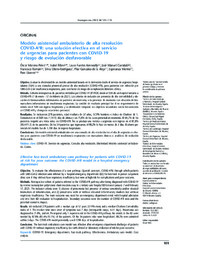Por favor, use este identificador para citar o enlazar este ítem:
https://hdl.handle.net/11000/31072Registro completo de metadatos
| Campo DC | Valor | Lengua/Idioma |
|---|---|---|
| dc.contributor.author | Moreno Pérez, Óscar | - |
| dc.contributor.author | Ribes, Isabel | - |
| dc.contributor.author | Fuertes Kenneally, Laura | - |
| dc.contributor.author | Carratalá, José Manuel | - |
| dc.contributor.author | Román, Francisco | - |
| dc.contributor.author | Otero Rodríguez, Silvia | - |
| dc.contributor.author | González de La Aleja, Pilar | - |
| dc.contributor.author | Merino, Esperanza | - |
| dc.contributor.author | Llorens Soriano, Pedro | - |
| dc.contributor.other | Departamentos de la UMH::Medicina Clínica | es_ES |
| dc.date.accessioned | 2024-02-05T12:45:20Z | - |
| dc.date.available | 2024-02-05T12:45:20Z | - |
| dc.date.created | 2022-04 | - |
| dc.identifier.citation | Emergencias 2022 Apr;34(2):103-110. | es_ES |
| dc.identifier.issn | 1137-6821 | - |
| dc.identifier.issn | 2386-5857 | - |
| dc.identifier.uri | https://hdl.handle.net/11000/31072 | - |
| dc.description.abstract | Objetivo. Evaluar la efectividad de un modelo asistencial basado en la derivación desde el servicio de urgencias hospitalarios (SUH) a una consulta presencial precoz de alta resolución (COVID-A2R), para pacientes con infección por SARS-CoV-2 sin insuficiencia respiratoria, pero con factor de riesgo de complicación/deterioro clínico. Método. Cohorte retrospectiva de pacientes remitidos por COVID-19 (RT-PCR) desde el SUH de un hospital terciario a COVID-A2R (7 de enero - 17 de febrero de 2021). Los criterios de inclusión son presencia de alta comorbilidad y elevación de biomarcadores inflamatorios en pacientes sin neumonía, o la presencia de neumonía con elevación de biomarcadores inflamatorios sin insuficiencia respiratoria. La variable de resultado principal fue el no requerimiento de revisita en el SUH con ingreso hospitalario y su distribución temporal. Los objetivos secundarios son la frecuentación en COVID-A2R y el impacto económico potencial. Resultados. Se incluyeron 278 pacientes, edad mediana de 57 años, 57,9% hombres e índice de Charlson de 1. Consultaron en el SUH tras 7 (4-11) días de clínica y un 71,8% de los casos presentaban neumonía. El 64,7% de los pacientes requirió una visita única en COVID-A2R. No se produjo una revisita a urgencias con ingreso en el 87,8% (83,4-91,1) de los pacientes. De los 34 pacientes que ingresaron, el 88,2% lo hizo en menos de 5 días. El ahorro potencial del modelo fue de 1.708 días de ingreso hospitalario. Conclusiones. Un modelo asistencial ambulatorio con una consulta de alta resolución tras el alta de urgencias es efectivo para pacientes con COVID-19 sin insuficiencia respiratoria con marcadores clínicos o analíticos de evolución desfavorable. | es_ES |
| dc.description.abstract | Objective. To evaluate the effectiveness of a care pathway (Spanish acronym, COVID-A2R) through which patients with SARS-CoV-2 infection were referred by a hospital emergency department (ED) for fast-track in-person outpatient clinic care if they did not have respiratory insufficiency but were at high risk for complications and poor outcome. Methods. Retrospective cohort of patients referred to the COVID-A2R pathway after being diagnosed with COVID-19 by reverse transcription polymerase chain reaction assay in a tertiary care hospital ED between January 7 and February 17, 2021. The inclusion criteria were 1) absence of pneumonia but presence of serious comorbidity and/or elevated biomarkers of inflammation, and 2) pneumonia with or without elevated inflammatory markers but without respiratory insufficiency. The main outcome was need for an emergency department revisit with hospital admission and time from ED evaluation to hospitalization. Secondary outcomes were the number of COVID-A2R visits and the potential economic impact. Results. We included 278 patients with a median age of 57 years (57.9% men) and a median Charlson Comorbidity Index of 1. The median time since onset of symptoms was 7 days (interquartile range, 4–11 days). Pneumonia was diagnosed in 71.8%, and 64.7% required only 1 in-person visit in the COVID-A2R pathway. No revisits to the ED were needed by 87.8% (83.4%–91.1%) of the patients. Of the 34 patients who were hospitalized, 88.2% were admitted within 5 days. The COVID-A2R model potentially saved 1708 days of hospitalization. Conclusion. The fast-track ambulatory care model was effective after emergency department discharge of patients with COVID-19 without respiratory insufficiency but with clinical or laboratory indicators of risk for poor outcome. | es_ES |
| dc.format | application/pdf | es_ES |
| dc.format.extent | 8 | es_ES |
| dc.language.iso | spa | es_ES |
| dc.publisher | SEMES Sociedad Española de Medicina de Urgencias y Emergencias | es_ES |
| dc.rights | info:eu-repo/semantics/openAccess | es_ES |
| dc.rights.uri | http://creativecommons.org/licenses/by-nc-nd/4.0/ | * |
| dc.subject | COVID-19 | es_ES |
| dc.subject | Servicio de urgencias | es_ES |
| dc.subject | Consulta alta resolución | es_ES |
| dc.subject | Efectividad | es_ES |
| dc.subject | Modelo asistencial ambulatorio | es_ES |
| dc.subject | Costes | es_ES |
| dc.title | Modelo asistencial ambulatorio de alta resolución COVID-A2R: una solución efectiva en el servicio de urgencias para pacientes con COVID-19 y riesgo de evolución desfavorable | es_ES |
| dc.type | info:eu-repo/semantics/article | es_ES |

Ver/Abrir:
Modelo asistencial ambulatorio de alta resolución COVID-A2R una solución efectiva en el servicio.pdf
295,14 kB
Adobe PDF
Compartir:
 La licencia se describe como: Atribución-NonComercial-NoDerivada 4.0 Internacional.
La licencia se describe como: Atribución-NonComercial-NoDerivada 4.0 Internacional.
.png)